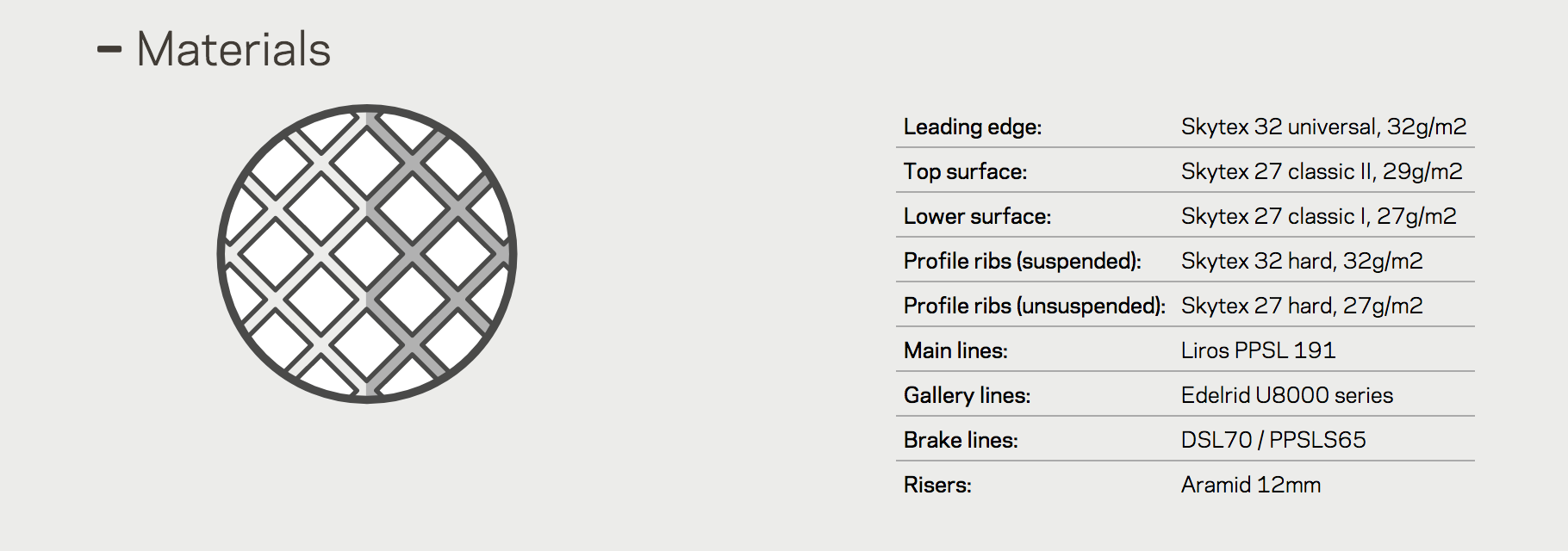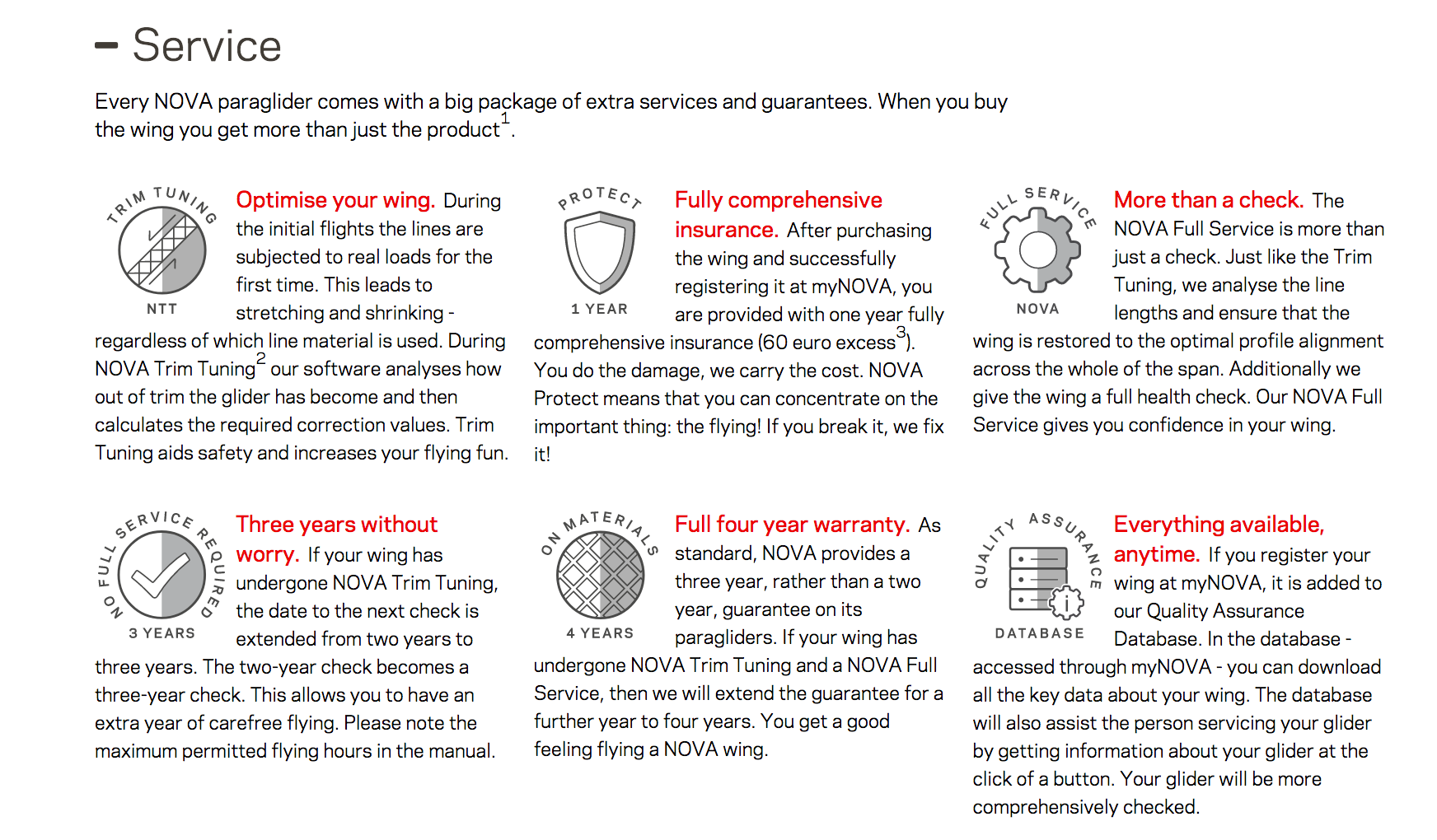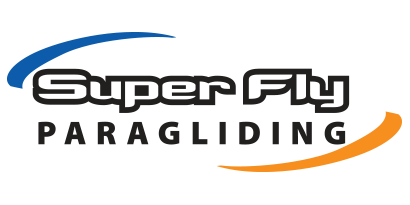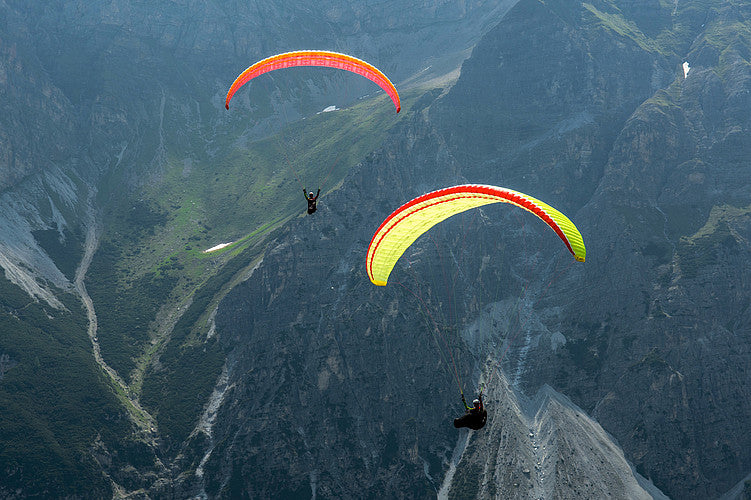MENTOR 5 Light
$4,700.00
Light, compact, high performance & safe (EN/LTF B)
MENTOR 5 light – the all-rounder
The MENTOR 5 light is the lightweight version of the MENTOR 5 – the master in its class. It weighs approximately 25 % less and can be packed much smaller than the standard version but it comes with all the advantages of the normal MENTOR 5. This makes it an all-rounder and offers you the freedom to undertake nearly every possible type of paragliding: cruising around local sites, paragliding holidays, hike & fly, vol-biv and ambitious cross-country flights.

Small packing volume – low weight. The MENTOR 5 light has all the advantages of its standard version but it weighs more than 25% less and is far more compact to pack. Other differences between the "normal" and the light version:
- The wing is easier to inflate and launch. Great for difficult alpine take-offs.
- Experienced pilots will sense slightly more feedback from the wing.
- Like all lightweight wings, the collapse and recovery characteristics are a little less dynamic.

Suitable for everyday flying – fully guaranteed. We deliberately do not construct our lightweight wings by pushing the limits of what is possible. Apart from the gallery lines, all lines are sheathed. They practically sort themselves. Launching is simple. The risers are not "Spaghetti-straps", but are conventional, aerodynamically slim risers with split A's. For years, our sensible compromise between durability and lightweight fabrics has proved itself reliable. We therefore provide our 3 year guarantee for the MENTOR 5 light too.

Real life performance – the benchmark. The MENTOR series has dominated the XC intermediate class for many years. All three of the longest FAI triangles flown on an EN B wing were completed on Mentor 3, 4 and 5s. The greatest of which is Berni Peßl's 300 km triangle. The MENTOR 5 light offers the same outstanding XC potential. The wing combines impressive performance, precise handling, excellent climb rate in thermals, as well as a high degree of passive safety for its classification (aspect ratio only 5.4). This impressive performance is easily accessible – even in strong thermals the wing ensures a relaxed and comfortable feeling in flight. A very important aspect for long XC-flights.

The all-rounder – one for all. The MENTOR 5 light is suitable for nearly all disciplines of paragliding. Every pilot values less weight and more compact equipment. This is even more important for hike & fly, when the gear has to be carried up the mountain. During hike & fly and vol-biv you will learn to appreciate the wing's simple launch characteristics. And if excellent glide performance in tricky conditions is required during vol-biv or cross-country flights, you will love the MENTOR 5 light.
Video
Demands

The MENTOR 5 light is a paraglider with impressive performance, which has – in the hands of an experienced pilot – very manageable handling and extreme flight behaviour. Yet, flying the MENTOR 5 light does require a certain level of skill and experience. Although certified as EN B, the MENTOR 5 light is not suitable for beginners or occasional pilots.


Attributes
Everything you need to know about the MENTOR 5 light:
- Less weight, more compact, same performance: the flying characteristics and performance are practically identical to the MENTOR 5.
- The lightweight construction (mostly high quality 27-g/m2 Porcher cloth) enhances the improved launch characteristics – the canopy inflates faster and it climbs overhead easily. A big advantage in difficult take-off spots, which are common in alpine terrain.
- The perforated profile and diagonal ribs have been analysed and optimised for strength. The consequence is less weight with a very high degree of durability.
- Completely suitable for everyday use: the MENTOR 5 light is covered by all guarantees and warranties as all NOVA paragliders. More on services and guarantees.
Impressions

"For me the MENTOR 5 is a very good mixture of a torpedo and a butterfly. I also noticed that after an eleven hour flight I was still fit and not feeling too tired."
Michael Müller (CH) flew a 292.88 km FAI triangle on his MENTOR 5 (XS) – at the time the Swiss FAI-record flight across ALL wing classifications!







Where the glider is flown in the weight-range is first and foremost a question of personal preference: anyone seeking a high degree of agility and dynamic flying should fly our wings at the higher end of the weight-range. Pilots who are happier with gentle flights with a high degree of damping will be happier in the middle of the weight-range. Of course, the flying conditions have a big influence - in turbulent, windy conditions greater wing loading will bring greater stability; whereas flying the glider at the lower end of the weight-range makes it unbeatable in weak thermals. Correct wing loading is mainly a question of personal preference and the conditions in which you mainly fly.
The brakes are components relevant to certification - modification can affect the flying characteristics and extreme flight behaviour. Because of this, we strongly advise against any modification of the brake system. It is important that the brake has sufficient travel before it engages. This is also important so that the wing does not brake automatically when the speed bar is used. Furthermore a brake that engages too early affects performance and influences the recovery during incidents, for example during a collapse or when the canopy goes parachutal.
Performance data depends heavily on the drag created by the pilot and this is linked to their seating position and harness type. An aerodynamic harness or seating position can make the difference of one glide ratio point. We at NOVA never determine absolute performance data, instead we make comparisons with reference gliders. For this reason we do not publish performance data.
How a pilot holds the brakes is a matter of personal preference - but it does have a marked influence on the handling and flying characteristics of the wing. We recommend a half-wrap. You hold the brake handle in your palm and twist it half way around your hand so that the brake line lies between your thumb and forefinger. This shortens the brake travel by approximately 20 centimetres and this has a positive effect on feedback - firstly you directly feel the travel of the brake line and secondly, with the arms positioned higher, it is easier to feel the wing. Due to poor ergonomics, we recommend against not taking this wrap. The exception is of course when gliding or during other phases of the flight when steering with the brake is not necessary. Please note: when changing from not having a wrap to taking the wrap, the shortened brake travel must be taken into consideration.
Simplicity is our motto. Our wings can be packed using a concertina bag, but it is not essential. In principle, all our wings can just be stuffed in a packsack. When the wing is folded it is recommended not to bend the rods unnecessarily. This is particularly true if the wing is to be stored for longer periods. Furthermore, we recommend careful handling of your wing.
Sail cloth, lines and all other components are subjected to rigorous testing before they are used in serial production. We not only test the sail cloth for durability (high porosity or reduced tear resistance through UV damage or wear) but also for mechanical robustness, for example stretching. For quality control purposes we regularly take samples during serial production.
During the initial flights the lines are first subjected to load. This load induces a small degree of stretching and shrinking. These are not associated with the line manufacturers or the quality of workmanship - in the factory all NOVA paragliders are trimmed and pre-stretched to within a very low tolerance. To adjust this stretching or shrinking, we recommend that the wing is taken for NTT (Nova Trim Tuning) after ten to twenty flights - after one year at the very latest. Generally, the line lengths remain constant after the first ten to twenty hours. To use make full use of the NTT, Nova encourages all pilots to have their wing checked after ten to twenty flying hours.
Dry, not packed too tightly and if possible in a space without wide temperature variations - these are the conditions that make our paragliders feel well. You should never store a wing when it is moist. You should also avoid excessive heat, like you would have, for example, in the car. Never remove dirt using chemical detergents and/or brushes.
XXS
XS
S
M

![[Product_title] - Super Fly Paragliding](http://superflyinc.com/cdn/shop/products/csm_NOVA_Mentor_5_light_12_a3cd5452d3_grande.jpg?v=1522418411)
![[Product_title] - Super Fly Paragliding](http://superflyinc.com/cdn/shop/products/csm_NOVA_Mentor_5_light_3_21f9a435ec_grande.jpg?v=1522418411)
![[Product_title] - Super Fly Paragliding](http://superflyinc.com/cdn/shop/products/csm_NOVA_Mentor_5_light_32_4de03f3793_grande.jpg?v=1522418411)
![[Product_title] - Super Fly Paragliding](http://superflyinc.com/cdn/shop/products/csm_m5-light-33_d1997dc5f9_grande.jpg?v=1522418411)
![[Product_title] - Super Fly Paragliding](http://superflyinc.com/cdn/shop/products/csm_NOVA_Mentor_5_light_9_95c01c24f9_grande.jpg?v=1522418411)
![[Product_title] - Super Fly Paragliding](http://superflyinc.com/cdn/shop/products/csm_m5-light-26_09da33196c_grande.jpg?v=1522418411)
![[Product_title] - Super Fly Paragliding](http://superflyinc.com/cdn/shop/products/csm_m5-light-23_44c916de77_grande.jpg?v=1522418411)
![[Product_title] - Super Fly Paragliding](http://superflyinc.com/cdn/shop/products/csm_m5-light-19_2e18da036b_grande.jpg?v=1522418411)
![[Product_title] - Super Fly Paragliding](http://superflyinc.com/cdn/shop/products/csm_NOVA_Mentor_5_light_22_25d0a36d8b_grande.jpg?v=1522418411)
![[Product_title] - Super Fly Paragliding](http://superflyinc.com/cdn/shop/products/csm_NOVA_Mentor_5_light_10_004077df9d_grande.jpg?v=1522418411)
![[Product_title] - Super Fly Paragliding](http://superflyinc.com/cdn/shop/products/csm_NOVA_Mentor_5_light_2_251aff1165_grande.jpg?v=1522418411)
![[Product_title] - Super Fly Paragliding](http://superflyinc.com/cdn/shop/products/csm_NOVA_Mentor_5_light_21_a2a19704d4_grande.jpg?v=1522418411)
![[Product_title] - Super Fly Paragliding](http://superflyinc.com/cdn/shop/products/csm_NOVA_Mentor_5_light_26_10ee56d44d_grande.jpg?v=1522418411)
![[Product_title] - Super Fly Paragliding](http://superflyinc.com/cdn/shop/products/csm_NOVA_Mentor_5_light_1_98c8c43d1c_grande.jpg?v=1522418411)
![[Product_title] - Super Fly Paragliding](http://superflyinc.com/cdn/shop/products/csm_NOVA_Mentor_5_light_4_Launch_806a5f5b82_grande.jpg?v=1522418411)
![[Product_title] - Super Fly Paragliding](http://superflyinc.com/cdn/shop/products/csm_NOVA_Mentor_5_light_6_Launch_135d6e9c13_grande.jpg?v=1522418411)
![[Product_title] - Super Fly Paragliding](http://superflyinc.com/cdn/shop/products/csm_652975371_d2621f0e2c_grande.jpg?v=1522418411)
![[Product_title] - Super Fly Paragliding](http://superflyinc.com/cdn/shop/products/csm_m5light-riser-2_137254b48f_grande.jpg?v=1522418411)
![[Product_title] - Super Fly Paragliding](http://superflyinc.com/cdn/shop/products/csm_m5light-riser-1_fc15f3348c_grande.jpg?v=1522418411)
![[Product_title] - Super Fly Paragliding](http://superflyinc.com/cdn/shop/products/csm_MENTOR5_Riser-6_946a52f9ce_1_grande.jpg?v=1522418411)
![[Product_title] - Super Fly Paragliding](http://superflyinc.com/cdn/shop/products/csm_MENTOR5_Riser-5_b1731d1467_1_grande.jpg?v=1522418411)
![[Product_title] - Super Fly Paragliding](http://superflyinc.com/cdn/shop/products/csm_MENTOR5_Riser-4_ff8d8f65e6_2_grande.jpg?v=1522418411)
![[Product_title] - Super Fly Paragliding](http://superflyinc.com/cdn/shop/products/csm_MENTOR5_Riser-3_7bdd1c3f85_2_grande.jpg?v=1522418411)

![[Product_title] - Super Fly Paragliding](http://superflyinc.com/cdn/shop/products/csm_NOVA_Mentor_5_light_12_a3cd5452d3_compact.jpg?v=1522418411)
![[Product_title] - Super Fly Paragliding](http://superflyinc.com/cdn/shop/products/csm_NOVA_Mentor_5_light_3_21f9a435ec_compact.jpg?v=1522418411)
![[Product_title] - Super Fly Paragliding](http://superflyinc.com/cdn/shop/products/csm_NOVA_Mentor_5_light_32_4de03f3793_compact.jpg?v=1522418411)
![[Product_title] - Super Fly Paragliding](http://superflyinc.com/cdn/shop/products/csm_m5-light-33_d1997dc5f9_compact.jpg?v=1522418411)
![[Product_title] - Super Fly Paragliding](http://superflyinc.com/cdn/shop/products/csm_NOVA_Mentor_5_light_9_95c01c24f9_compact.jpg?v=1522418411)
![[Product_title] - Super Fly Paragliding](http://superflyinc.com/cdn/shop/products/csm_m5-light-26_09da33196c_compact.jpg?v=1522418411)
![[Product_title] - Super Fly Paragliding](http://superflyinc.com/cdn/shop/products/csm_m5-light-23_44c916de77_compact.jpg?v=1522418411)
![[Product_title] - Super Fly Paragliding](http://superflyinc.com/cdn/shop/products/csm_m5-light-19_2e18da036b_compact.jpg?v=1522418411)
![[Product_title] - Super Fly Paragliding](http://superflyinc.com/cdn/shop/products/csm_NOVA_Mentor_5_light_22_25d0a36d8b_compact.jpg?v=1522418411)
![[Product_title] - Super Fly Paragliding](http://superflyinc.com/cdn/shop/products/csm_NOVA_Mentor_5_light_10_004077df9d_compact.jpg?v=1522418411)
![[Product_title] - Super Fly Paragliding](http://superflyinc.com/cdn/shop/products/csm_NOVA_Mentor_5_light_2_251aff1165_compact.jpg?v=1522418411)
![[Product_title] - Super Fly Paragliding](http://superflyinc.com/cdn/shop/products/csm_NOVA_Mentor_5_light_21_a2a19704d4_compact.jpg?v=1522418411)
![[Product_title] - Super Fly Paragliding](http://superflyinc.com/cdn/shop/products/csm_NOVA_Mentor_5_light_26_10ee56d44d_compact.jpg?v=1522418411)
![[Product_title] - Super Fly Paragliding](http://superflyinc.com/cdn/shop/products/csm_NOVA_Mentor_5_light_1_98c8c43d1c_compact.jpg?v=1522418411)
![[Product_title] - Super Fly Paragliding](http://superflyinc.com/cdn/shop/products/csm_NOVA_Mentor_5_light_4_Launch_806a5f5b82_compact.jpg?v=1522418411)
![[Product_title] - Super Fly Paragliding](http://superflyinc.com/cdn/shop/products/csm_NOVA_Mentor_5_light_6_Launch_135d6e9c13_compact.jpg?v=1522418411)
![[Product_title] - Super Fly Paragliding](http://superflyinc.com/cdn/shop/products/csm_652975371_d2621f0e2c_compact.jpg?v=1522418411)
![[Product_title] - Super Fly Paragliding](http://superflyinc.com/cdn/shop/products/csm_m5light-riser-2_137254b48f_compact.jpg?v=1522418411)
![[Product_title] - Super Fly Paragliding](http://superflyinc.com/cdn/shop/products/csm_m5light-riser-1_fc15f3348c_compact.jpg?v=1522418411)
![[Product_title] - Super Fly Paragliding](http://superflyinc.com/cdn/shop/products/csm_MENTOR5_Riser-6_946a52f9ce_1_compact.jpg?v=1522418411)
![[Product_title] - Super Fly Paragliding](http://superflyinc.com/cdn/shop/products/csm_MENTOR5_Riser-5_b1731d1467_1_compact.jpg?v=1522418411)
![[Product_title] - Super Fly Paragliding](http://superflyinc.com/cdn/shop/products/csm_MENTOR5_Riser-4_ff8d8f65e6_2_compact.jpg?v=1522418411)
![[Product_title] - Super Fly Paragliding](http://superflyinc.com/cdn/shop/products/csm_MENTOR5_Riser-3_7bdd1c3f85_2_compact.jpg?v=1522418411)



Connect